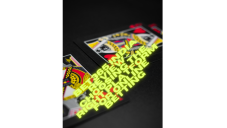What Is A Ballistic Vest And What Does It Protect Our Soldiers From?
Dhir Acharya - Dec 02, 2019

Ballistic vest have become more widely used in recent years, not only for soldiers when they're on a mission but also for citizens.
- This AI Defense System Forces Drones To Land Autonomously
- China's New Suicide Drones Pose Dangers To Other Countries' Defense Systems
- North Korea Shows Off The World's Biggest Ballistic Missile Of Its Kind, Taking On The US
A ballistic vest is also known as a bulletproof vest. Essentially, it’s a personal armor, worn on the torso, which absorbs the impact while reducing or stopping shrapnel from explosions as well as penetration from firearm-fired projectiles to the wearer’s body. Soft vests include multiple layers formed with laminated or woven fibers with the ability to protect its wearer from shotgun projectiles, small-caliber handgun, as well as small fragments from hand grenades and other explosives.

Usually, a ballistic plate is inserted into bulletproof vests. A soft vest can have ceramic or metal plates to further protect the wearer from rifle rounds, along with tightly woven fiber layers or metallic components to provide resistance to slash attacks and stab from close-quarter weapons like knives. Normally, soft vests serve police forces, bodyguards, security guards, and citizens facing the risk of being shot. Meanwhile, vests reinforced with hard plates are mostly for hostage rescue teams, police tactical units, as well as combat soldiers.
In body armor, a bulletproof vest can be combined with other protective clothing items, a combat helmet for example. Vests made for military and police use may add ballistic shoulder as well as armor components for side protection while bomb disposal officers often wear heavy armor along with helmets featuring spine protection and face visors.
In a ballistic vest, there are layers formed by strong fibers that catch and change its shape into a dish, which spreads its force across a larger area of the vest. Absorbing the bullet’s energy, the vest stops the bullet before it's able to penetrate the fiber layers completely. The bullet may penetrate some layer but as it deforms, the fiber area absorbing its energy expands.

A ballistic vest has the ability to prevent a bullet from penetrating, itself and the wearer still absorbs the impulse of the bullet. Even though the bullet cannot penetrate, its force is enough to generate blunt force trauma under the affected point. Typically, vest specifications include both limits on the impact force delivered to the body as well as penetration resistance requirements.
While some bullets can still penetrate the vest, they will cause low damage to the wearer due to speed loss and their small form.
Vests that are made for bullet-resistance don't offer as much protection from blows from bullets made of hardened materials like steel or sharp implements like ice picks, arrows, and knives. The reason is that those objects have the impact force concentrating in a small area, which allows them to better puncture the layers of fiber on most bullet-proof fabrics of soft armor. On the contrary, stab vests better protect you from sharp implements; however, they are not as good with bullets. And there's a misunderstanding about soft armor that they provide protection from most slashing attacks while in reality, this optimism bias exposes the wearer to even greater risk.
Textile vests can be augmented with polyethylene, ceramic, or metal plates to provide additional protection for vital areas, which have proven themselves effective against various rifles as well as all handgun bullets. Such upgraded bulletproof vests are now standard use in the military since soft armor can't provide protection from military rifle rounds. Police and prison guards usually wear vests specifically designed against sharp objects and bladed weapons. They may incorporate laminated and coated metallic components or para-aramid textiles.

There are six levels of armor when it comes to bulletproof vests based on the types of guns and attacks they offer protection against.
Type I protects wearers from 2.6g .22 bullets from Long Rifle Lead Round Nose at 329 meters per second, as well as 6.2g .380 bullets from ACP Full Metal Jacketed Round Nose (FMJ RN) at 322 meters per second. However, this armor level is not part of the standard anymore.
Type IIA offers protection like Type I, but also protects you from 8g 9x19mm bullets from Parabellum FMJ RN, 11.7g .40 bullets from S&W Full Metal Jacketed, and 14.9g .40 bullets from ACP FMJ.
Meanwhile, Type II protects you from 8g 9mm bullets from FMJ RN and 10.2g .357 bullets from Magnum Jacketed Soft Point. Additionally, it offers protection against threats in Type I and Type IIA.
Type IIIA protects wearers from 8.1g .357 bullets from SIG Full Metal Jacketed Flat Nose and 15.6g .44 bullets from Magnum Semi Jacketed Hollow Point, in addition to protection against threats in Type I, Type IIA, and Type II.
Type III armor offers protection from 2.0g FN 5.7x28mm bullets from Full Metal Jacketed, 8.0g 7.62x39mm bullets from FMJ, 9.6g 7.62x51mm ball bullets from NATO M80, and 19.7g .45-70 bullets made of solid copper. And it works against threats in all the Types mentioned above.
Finally, Type IV provides protection against 10.8g .30-60 bullets from Springfield M2 AP apart from threats in Type I, Type IIA, Type II, Type IIIA, and Type III.
Featured Stories

Features - Jan 23, 2024
5 Apps Every Creative Artist Should Know About

Features - Jan 22, 2024
Bet365 India Review - Choosing the Right Platform for Online Betting

Features - Aug 15, 2023
Online Casinos as a Business Opportunity in India

Features - Aug 03, 2023
The Impact of Social Media on Online Sports Betting

Features - Jul 10, 2023
5 Most Richest Esports Players of All Time

Features - Jun 07, 2023
Is it safe to use a debit card for online gambling?

Features - May 20, 2023
Everything You Need to Know About the Wisconsin Car Bill of Sale

Features - Apr 27, 2023
How to Take Advantage of Guarantee Cashback in Online Bets

Features - Mar 08, 2023
White Label Solutions for Forex

Review - Jul 15, 2022
Comments
Sort by Newest | Popular